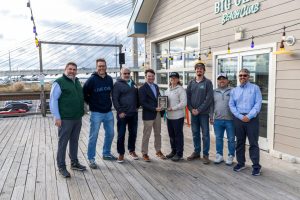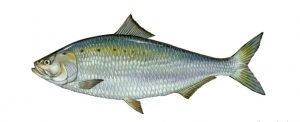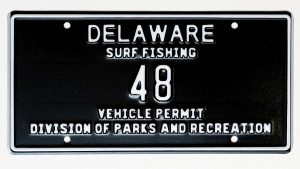 DOVER – When the U.S. Army Corps of Engineers struck rock bottom during deepening of the Delaware River navigational channel, the state’s artificial reef program under the Department of Natural Resources and Environmental Control’s Division of Fish & Wildlife struck a new partnership with the Corps of Engineers for creating new fish habitat. Since last December, DNREC’s Fisheries Section and the Corps have partnered on a beneficial reuse project for converting nearly a million tons of rock removed from the river bottom into enhanced habitat for marine life on two artificial reef sites in the lower Delaware Bay – and at no cost to the state.
DOVER – When the U.S. Army Corps of Engineers struck rock bottom during deepening of the Delaware River navigational channel, the state’s artificial reef program under the Department of Natural Resources and Environmental Control’s Division of Fish & Wildlife struck a new partnership with the Corps of Engineers for creating new fish habitat. Since last December, DNREC’s Fisheries Section and the Corps have partnered on a beneficial reuse project for converting nearly a million tons of rock removed from the river bottom into enhanced habitat for marine life on two artificial reef sites in the lower Delaware Bay – and at no cost to the state.
“This project is a shining example of state and federal cooperation that achieves better management and use of natural resources,” said DNREC Secretary Shawn M. Garvin. “We are grateful for the opportunity to team with the Corps on a project that yields such outstanding environmental and economic benefits – ranging from better navigation of the Delaware River for commercial shipping, to improving fisheries habitat, to increasing anglers’ opportunities in Delaware waters.”
“The Corps greatly appreciates being able to join forces with our DNREC partners and the State of Delaware on such an innovative project,” said Lt. Col. Kristen Dahle, Commander of the U.S. Army Corps of Engineers’ Philadelphia District. “Beneficially using rock from the Delaware River navigation channel to create enhanced habitat aligns engineering with natural processes, and maximizes scarce resources. These types of projects create triple-win outcomes integrating social, environmental and economic benefits.”
During the Corps of Engineers’ deepening of the river’s navigational channel to 45 feet to accommodate larger ships coming into port, two types of rock were encountered between Wilmington and Philadelphia: bedrock and more abundant glacial rock that washed downstream during the most recent ice age that spanned some 2.6 million years. In some parts of the river, almost 5 feet of bedrock (amounting to 355,000 tons) was removed to ensure the navigation depth. That rock was transported by Great Lakes Dredging Co., a Corps of Engineers contractor, and deployed to Delaware Reef Site #4, south of Bowers Beach and north of Mispillion Inlet, expanding the reef’s structure to 50 percent of its planned development by the Division of Fish & Wildlife.
Glacial rock taken from the river bottom yielded even more extraordinary reefing material for DNREC. From December through March, more than 635,000 tons of glacial rock was moved by another Corps’ contractor, Norfolk Dredging Co., by barge to the Brown Shoal reef site #6 and piled in mounds 15 to 20 feet high amidst bottom consisting mostly of mud and sand. The addition of glacial rock means that reef site #6 is fully developed, expanding recreational fishing opportunities for the increasing number of anglers who fish Delaware’s world-class artificial reef system each year.
Both kinds of rock delivered by the Corps of Engineers are a boon to the artificial reef system and superior to many other reefing materials used by the program. Natural rock is a very rare habitat type in the mid-Atlantic region and supports a very rich, diverse and novel invertebrate community, dominated by blue mussels. Fish benefit from the protection this habitat provides and also from an increase in food availability from the invertebrates occupying the rocks.
For more information about the beneficial reuse project between DNREC and the Corps of Engineers, please visit the Division of Fish & Wildlife website.
Media contact: Michael Globetti, DNREC Public Affairs, 302-739-9902
Vol. 48, No. 185
-30-















































































